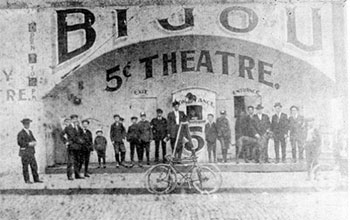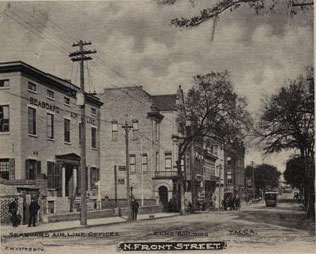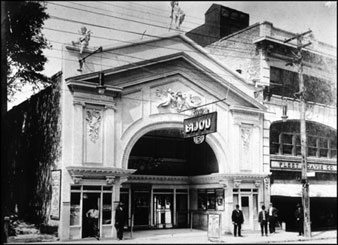Going to the Show: Lesson Plans
Conduct your own oral history project
Introduction | Activities 1 - 3 | Activities 4 - 6 | Oral History Record Packet | Learn More
ACTIVITIES
The introductory activities for this lesson plan will access historical theater information available from the UNC "Going to the Show" online digital collection (http://docsouth.unc.edu/gtts/ ) and oral histories available from the UNC DocSouth "Oral Histories of the American South" online digital collection (http://docsouth.unc.edu/sohp/ ). Otherwise, the students' activities will be primarily focused on conducting and analyzing oral history interviews.
Activity One: Activating background knowledge
Explain to students that they will be conducting a series of activities that explore the moviegoing experience, both now and in earlier historical times. The major focus will be conducting oral history interviews, both with peer students as well as with family and/or friends to get insights about the moviegoing experience from older generations.
In this brief introductory activity, students will collectively brainstorm ideas about their experiences about going to the movies, both now and their perceptions about moviegoing in earlier times. This encourages students to begin thinking about the topic and prepares them for questions they might want to ask during their oral history interviews.
Read students the following prompts, or write them on the board or overhead projector.
Give students time to generate ideas and questions.
Teachers may want to write down / capture student responses on the white board or overhead project, using a 2-column format for "today" and "yesteryear."
Part A: Contemporary moviegoing:
- What do you remember about your earliest experiences watching movies?
- Where do people see movies? Note: This question references movies, in general. Students should be thinking about seeing movies at home (DVD, television, pay-per-view, as well as going to a theater to see movies).
- How often do you watch movies? at home? at theater?
- Why do people go to the movies? Note: This questions focuses more on why people would go to a movie theater to see a movie.
- How far do you travel to watch a movie at a theater?
- How long does it take to get there?
- How do you travel to a movie theater?
- How much does it cost to see a movie? Note: today there are several variations on this given the variety of movie viewing options, including theaters, pay-per-view, DVDs (whether rented or purchased), subscriptions (e.g. HBO, Showtime, etc.), and "free" movies available on "network" television.
Part B: Historic moviegoing:
- Revisit the above questions but have students hypothesize what they think the answers would be for someone of their grandparents' generation or from someone in the early 1900s. Note: 8th-graders are 13 years old, so assume their parents are in their early 30s to late 40s and that their grandparents are in their 50s or older. The parents would therefore have been born 1969-1979, grandparents would have been born 1939-1959.
- Encourage students to start thinking about possible interviewees: parents, grandparents, aunts, uncles, and other older relatives; neighbors; family friends; or other community members who would be willing to be interviewed.
Activity 2: Research going to the movies in the early 1900s
1. Explain to students that they will now have a chance to learn a bit more about moviegoing in the early 1900s. This should give them some additional perspective in the differences between then and now and give them enough understanding and context to interview someone about it.
Have students read "Moviegoing in Early 20th-Century North Carolina" by Robert Allen:
http://docsouth.unc.edu/highlights/moviegoing.html
(Have students wait to review the oral history excerpts on the page—they'll get to that in the next activities)
Have students review the following images and news clippings related to the Bijou Theatre, the first permanent moving picture house in Wilmington, and maybe even North Carolina. The theatre opened in December 1906.
This photo is of the original Bijou Theatre. It was built of canvas and wood and had a sawdust floor.
How might this have affected the moviegoing experience?

http://docsouth.unc.edu/gtts/content/2403
This view is looking north on North Front Street, taken just to the north of the Bijou Theatre. Imagine walking out the door of the Bijou and turning left—this is what you would have seen (time 1900-1910).

http://dc.lib.unc.edu/cdm4/item_viewer.php?CISOROOT=/nc_post&CISOPTR=2237&CISOBOX=1&REC=19
Bijou Theatre news clippings (http://docsouth.unc.edu/gtts/venue/1171 ):
- Proposed theater- Bijou - Tent (Wilmington Star - 11/28/1906)
http://docsouth.unc.edu/gtts/content/318/ - The Five-Cent Theatre to Open - Bijou (Wilmington Star - 12/22/1906)
http://docsouth.unc.edu/gtts/content/320/ - Xmas Eve in the City - Immense Crowds Throng Downtown Streets (part 1) (Wilmington Messenger - 12/24/1906)
http://docsouth.unc.edu/gtts/content/321/ - Xmas Eve in the City - Immense Crowds Throng Downtown Streets (part 2) (Wilmington Messenger - 12/24/1906)
http://docsouth.unc.edu/gtts/content/322/ - Managers Make a Change that Will Increase the Popularity of Theatre (Wilmington Dispatch - 4/8/1907)
"Always going on, never out and never over" http://docsouth.unc.edu/gtts/content/326/ - See the New Pictures at the Bijou (Wilmington Dispatch - 4/24/1907)
http://docsouth.unc.edu/gtts/content/328/ - Teacher Supplemental Note: This clipping encourages parents to "leave their children at the Bijou while they are shopping, the management guaranteeing that they will be taken care of."
- Illustrated Songs at Bijou (Wilmington Star - 9/17/1907)
http://docsouth.unc.edu/gtts/content/341/ - Changes Are Now Daily (Wilmington Star - 9/20/1907)
http://docsouth.unc.edu/gtts/content/344/ - The Bijou - Bring Children (Advertisement Wilmington Dispatch - 1/18/1911)
http://docsouth.unc.edu/gtts/content/371/ - The Bijou Collapses - Moving Picture Theatre Gave Way Under Weight of Snow (Wilmington Star - 2/13/1912)
http://docsouth.unc.edu/gtts/content/375/
A permanent building was built for the Bijou Theatre and opened in May 1912.
Teacher Note: The Bijou Theatre was unusual for its time in that it was custom built and in a dedicated building. Most of the theaters at the time "repurposed" an existing commercial space, usually the first floor, and often shared a building with other businesses.

http://docsouth.unc.edu/gtts/content/2404/
Review the news clippings below for more details on the Bijou theater.
Bijou Theatre news clippings (http://docsouth.unc.edu/gtts/venue/1171 ):
- Fine New Theatre (Wilmington Dispatch - 12/8/1911)
http://docsouth.unc.edu/gtts/content/374/ - Bijou Opened Last Night - racial policy(balcony), admission price, capacity (Wilmington Morning Star - 5/31/1912)
http://docsouth.unc.edu/gtts/content/782/ - Pipe Organ Installed - Bijou (Wilmington Star - 7/10/1916)
http://docsouth.unc.edu/gtts/content/407/ - Bijou - Advertisement - Inaugural Parade of President Wilson (Wilmington Star - 4/8/1917)
http://docsouth.unc.edu/gtts/content/412/ - Bijou - Surrender of the German Fleet ( Wilmington Dispatch - 1/1/1919)
http://docsouth.unc.edu/gtts/content/422/
2. Decide if students will generate their own questions individually or in groups, or if you will provide the questions for them (refer to the "Moviegoing Oral History Sample Questions" included in the Conducting an Oral History student packet).
3. Organize the students into groups of 3 to conduct their contemporary peer interviews.
Activity 3: What is an oral history?
1. Introduce the concept of oral histories, and discuss their value as we study important events. Mention that oral histories provide a chance for the "regular person" to record his or her experiences, not just the well-known or famous people often recorded in written history.
2. Ask students to come up with more reasons we should value oral histories - such as making connections between generations, capturing experiences that are no longer available, allowing minority groups to record and publicize their experiences, and passing on the art of storytelling. (For more about oral histories, see the LEARN NC guide, "Oral History in the Classroom." (http://www.learnnc.org/lp/editions/oralhistory2002/ )
3. Explain that students will hear oral history excerpts that include references to their moviegoing experiences from North Carolinians. These will be accessed from UNC's DocSouth Oral Histories of the American South online digital collection (http://docsouth.unc.edu/sohp/ ). Teacher Note: The references to moviegoing are rather sparse in the following oral histories. You might want to look at the transcripts first. However, a key value of this activity is hearing the stories in the interviewee's voice. You also might want to have students listen to all of the oral history excerpts first, and then have a brief discussion.
4. Hand out the transcripts of the oral history excerpts to students.
5. Play the following oral histories for students:
- The speakers are George and Tessie Dyer who worked in Charlotte textile mills for much of their lives. In this interview they share some of their recreational activities, including going to the movies: http://docsouth.unc.edu/sohp/H-0161/ (search for movie).
- The speaker is Murphy Yomen Sigmon who entered the workforce at the age of fourteen and held a variety of jobs in North Carolina industries before a mill shutdown ended his long working life. In an excerpt from the interview, he shares his experience about going to the movies in Hickory, North Carolina: http://docsouth.unc.edu/sohp/H-0142/ (search for moving picture).
excerpt: Moviegoing in Hickory, North Carolina: http://docsouth.unc.edu/sohp/H-0142/excerpts/excerpt_5342.html - The speaker is Margaret Skinner, who was born in Ireland. In this interview she discusses her experiences working at the company store of a cotton mill in Cooleemee, North Carolina. She remembers some of the daily routines and what they did for fun, including watching movies: http://docsouth.unc.edu/sohp/H-0278/ (search for movie).
- The speaker is Ethelene McCabe Allen, who was born to tenant farmers and spent most of her childhood moving around Wayne County and Johnston County, North Carolina. In this interview she recalls her childhood during the 1930s and 1940s, including their leisure activities: http://docsouth.unc.edu/sohp/C-0316/.
- The speaker is Viola Turner, born February 17, 1900, the only child of her African American teenage parents. The latter portion of this interview focuses on her descriptions of entertainment and race relations. Specifically, Turner describes her interaction with various black performers and her experiences attending both black and white theaters in Durham. In addition, she explains her friendship with Eula Perry—who could easily "pass" for white—and the reactions their friendship elicited from various observers.: http://docsouth.unc.edu/sohp/C-0015/menu.html (search for theatre).
6. Discussion questions:
- How often did people go to the movies?
- How did people get to the movies?
- Where was the movie theater located? (downtown? in a building shared with other businesses?)
- What kind of movies did they see?
- How do the oral histories relate to the photos and news clippings referenced above?
- How much did it cost to see a movie?
Introduction | Activities 1 - 3 | Activities 4 - 6 | Oral History Record Packet | Learn More